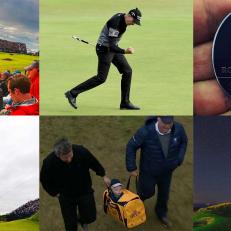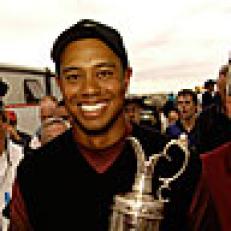
Sandy Herd's Haskell Ball, 1902
During a practice round prior to the 1902 British Open at Hoylake, Sandy Herd played with amateur John Ball. Herd noticed Ball was not only using Haskell rubber-center balls instead of a guttie, but was consistently out-driving him. Herd reluctantly went into the pro shop at the end of the round, bought some of the newfangled balls and went on to win that year's Open by one stroke over Harry Vardon and James Braid.
Harry Vardon's Vardon Flyer ball, 1903
There has been no more dominant player in the British Open than Harry Vardon, who won the event six times (1896, 1898, 1899, 1903, 1911 and 1914). After his third Open win, Spalding approached Vardon with the idea of making a gutta-percha ball that would bear Vardon's name. Out of that came the Vardon Flyer, a ball Vardon used during his 1903 British Open victory. Although the ball never took hold with the public, The USGA Museum displays an original Vardon Flyer golf ball and the ball's packaging.
Gene Sarazen's Wilson sand wedge, 1932
Gene Sarazen's invention of the modern sand wedge is a well-worn tale that bears repeating. While being taught by Howard Hughes how to fly a plane, Sarazen took note of how a plane's tail adjusted downward during takeoff, spawning an idea. Sarazen reached out to his equipment company, Wilson, and had them send him half-a-dozen niblicks (the equivalent of a 9-iron). Using solder, Sarazen experimented with different amounts of mass on the sole of the clubs until he found one he felt would easily extricate the ball from sand. Sarazen took the club to the 1932 British Open, taking care to keep the club under wraps for fear it would be deemed illegal before play began. Sarazen used the club during his win at Prince's.
Greg Norman's Spalding Tour Edition ball, 1986
Greg Norman won his first major in 1986, but while the world marveled at his record-setting opening round 63 and his eventual five-shot victory that surely heralded the much-anticipated arrival of the next Nicklaus, it was the ball he used that might have signaled the greatest sea change in the game. Norman's Spalding Tour Edition was a two-piece, non-wound ball, the first such construction to win a major championship in the modern era.
John Daly's UST shafts, 1995
Although shaftmaker United Sports Technologies (UST) had been around for a few years come the 1995 British Open, it was John Daly's win at St. Andrews that brought significant attention to the fledgling brand. "Long John" used the company's Tour Weight graphite shaft not only in his Wilson Invex driver, but in his irons as well.
Mark O'Meara's Top-Flite Strata ball, 1998
Four years before Tiger Woods started dismantling tournament records with the multilayer Nike Tour Accuracy, Mark O'Meara was using the solid-core, multilayer Top-Flite Strata. Although not many players paid much attention to that, once O'Meara won the 1998 Masters and then later that year, the British Open at Royal Birkdale, the acceptance of such a ball by the top players in the world grew. By 2002, thanks largely to the success of the Titleist Pro V1, wound golf balls had all but disappeared from the PGA Tour.
Jean Van de Velde's Never Compromise putter, 1999
Jean Van de Velde made enough putts with a Never Compromise putter during the 1999 British Open at Carnoustie that he held a three-shot lead coming to the 72nd hole. We all know how that played out, but although he lost the playoff to Paul Lawrie, the cameras zoomed in often enough on the Never Compromise name on the back of Van de Velde's flat stick to bring the company the kind of notoriety it needed. A year after his epic collapse, Never Compromise brought Van de Velde back to Carnoustie to play the 18th armed only with is putter. He made 6, a score that would have won the Open a year earlier. The video still lives on YouTube.
David Duval's Nike Equipment, 2001
Tiger Woods gets most of the credit for putting Nike's swoosh in the minds of golf equipment buyers, but he wasn't the first player to win a major title actually using a set of Nike irons. That honor belongs to David Duval, whose prototype set of forged Nike irons were in the bag for his win at the 2001 Open Championship at Royal Lytham. The victory, which featured a third-round 65 in which Duval didn't have a birdie putt longer than 12 feet, was a coming-out party for an iron design that through Duval's input would become the Forged Pro Combo, which was introduced the next year.
Todd Hamilton's Sonartec hybrid, 2004
No one may have better first-hand knowledge of the versatility of hybrid clubs than Todd Hamilton, who got up-and-down an astonishing 13 of 14 times with his Sonartec MD Transition club (a 17-degree model bent to 14 degrees) during his playoff win at 2004 British Open at Royal Troon. So amazing was Hamilton's prowess with the club (he used it to tee off on several holes as well as for some approach shots as well as chipping) that five days after the Open, Sonartec received a call from the R&A to see if the club conformed to the Rules of Golf. Luckily for Hamilton, it did. And just as fortuitous for everyday golfers was the exposure it brought to hybrids, a club that is now a must-have for the majority of players.















